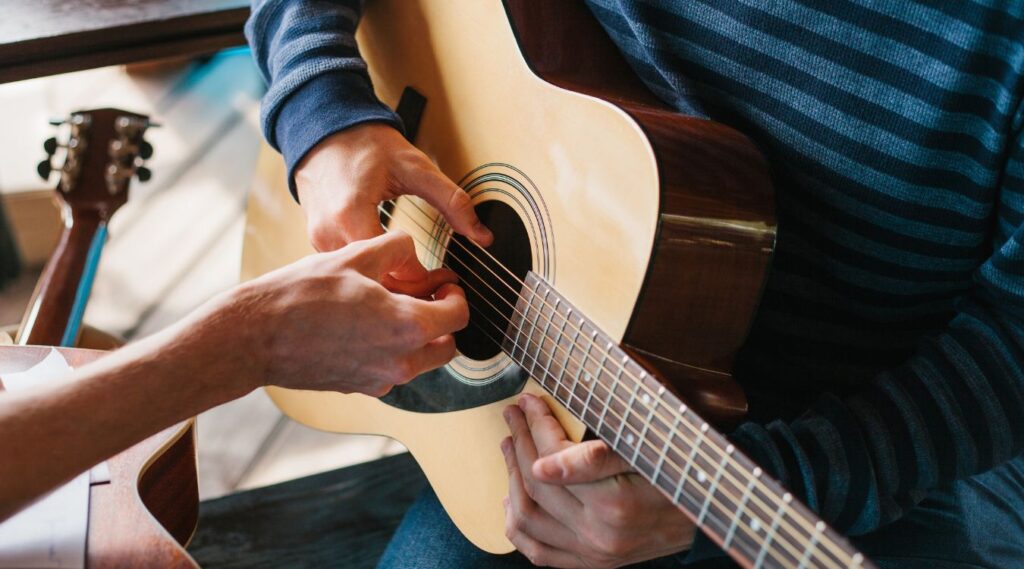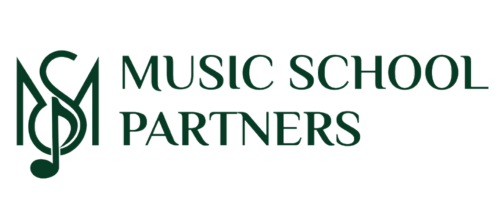Guitar Lesson Marketing
Your Complete Guide to Get More Guitar Students
Picture this: Your ideal student sits down with their guitar, excited for their first lesson with you. That’s the moment we’re working toward—connecting your passion for music with eager learners ready to grow.
This guide is your go-to for marketing your guitar lessons. We’re here to help you lay the foundation for your business and share practical, easy-to-follow tips to help it grow in a way that feels natural and manageable for you. So grab a cup of coffee (or your guitar) and let’s get started!
Does Guitar Lesson Marketing Feel Like “Selling Out?”
It shouldn’t.
Some musicians worry that marketing feels like “selling out.” But it doesn’t have to! Marketing is really just about connecting with students who are excited to learn from you. It’s all about sharing your passion for music in a way that feels true to who you are.
Think about your favorite songs—each one tells a story and connects with the listener. When students see what makes your lessons unique, it becomes so much easier to draw in those who can’t wait to learn from you.
The only ‘selling’ you are doing is you, to your potential students.

1. Build a Strong Foundation for Your Guitar Lessons
Before diving into the nitty-gritty of marketing, let’s start with the basics.
Define Your Teaching Approach
Maybe you specialize in helping beginners master their first chords through playful, interactive lessons—or perhaps you’re the go-to school for advanced rock enthusiasts aiming for shredding perfection. The way you teach and what you care about will naturally guide how you market your lessons.
Ask yourself:
- Who do I want to teach? (Kids, teens, adults, beginners, advanced players?)
- What makes my lessons different? (Are you fun, laid-back, structured, or goal-oriented?)
- What’s my “why”? (Why do I love teaching guitar?)
Action Step: Write down your teaching style, target audience, and unique selling points. Use this as the basis for your website’s messaging.
Choose Your Format
If you teach online, emphasize convenience and flexibility. When teaching in person, highlight how hands-on learning can help students improve and feel more confident.
Here’s a quick breakdown:
- In-Person Lessons: Ideal for hands-on guidance and building strong connections.
- Online Lessons: Perfect for reaching students outside your local area.
- Hybrid Lessons: Combine the best of both worlds for maximum flexibility.
If you choose only lesson primarily, just note you will be competing with a much larger market, since there are many more people able o service the same customer.
The opposite would be parents who go to Google and search “guitar lessons near me.” Their intent is to find someone local for their child.
2. Low-stress Ways to Grow Your Student Roster
Tap Into Your Local Community
Getting those first students is often the toughest part. We typically work with music schools that have completed this ‘proof of concept’ since it proves that what you are selling can be sold – even before you spend a dime. Here are a few easy ways to start:
Partner with Schools and Music Shops: Introduce yourself to local schools, band directors, and music stores. They’re often looking for guitar lessons to recommend.
Volunteer: Offer free mini-lessons or workshops at community events. It’s a great opportunity to showcase what you can do and spark interest from students who’d love to learn with you.
Use Community Boards: Post flyers or business cards in coffee shops, libraries, or grocery stores. Local Facebook groups can also be a place to start.


Let Your Happy Students Spread the Word
Happy students are your best marketing tool. Ask them to share their experience with friends and family—it’s one of the best ways to grow your student base!
You can even create a simple referral program, for example, you could offer a $10 gift card or a free group lesson to students who refer a friend.
3. Create an Online Presence That Hits the Right Note
These days, having an online presence is a must for music schools that want to attract more students and grow their reputation. Whether you teach online or in person, a smart digital plan can help you stand out in a big way.
Standing Out in a Crowded Market
To stand out online, you need more than just a list of services. You need a unique selling point (USP). What makes your lessons special? Maybe it’s your teaching style, your content, or a specific genre you focus on.
Look at what other schools are doing for ideas, but don’t forget to sprinkle in your unique flair—whether it’s a touch of humor, specific tips, or your own twist on teaching music.
Ultimately, there are a ton of options in the marketplace. Do you want to be a teacher specializing in teaching kids? Maybe jazz?
Whatever it is, just make sure your local market can support it. If you only want to learn blues, but people do not want to learn blues, you might find it tough to build a larger base of students.
Analyzing Competitors to Sharpen Your Strategy

Understanding what your competitors are doing can help you find your place. Pick a few competitors on Google, check their reviews, see what they’re doing well, and think about how you can do it better or differently.
If they offer group lessons, and you prefer one-on-one teaching, highlight the benefits of personalized instruction.
Boosting Your Website’s Visibility with Search Engine Optimization
o start, if you are not sure what search engine optimization (SEO) is, check out this resource.
Use keywords your ideal students might search for, like “beginner guitar lessons” or “piano lesson near me.” Sprinkle these into your website, blog, and social posts to boost your visibility.
Creating a blog section with topics like “Top 5 Tips for Beginners Picking Up the Guitar” or “How to Choose the Right Guitar Lesson” can also add value and boost search rankings.
Teaching locally? Focus on Local SEO. Add location keywords like “guitar lessons in [Your City].” Create a Google Business Profile and get listed in local directories so students nearby can easily discover you.
An optimized Google profile can help local students discover you faster. Here’s how we helped a music school in Tampa rank in top 3 from getting buried beyond the top 20 positions.
Building a Website That Attracts Music Students
Think of your website as the first meeting with a new student—friendly, clear, and professional. Your website should feel warm and inviting, look professional, and be super easy to use.

Website Essentials Checklist:
- Homepage: A clear, inviting introduction that highlights what you offer.
- About Page: Share your teaching style, experience, and passion for music. Let your personality shine!
- Lessons Page: Include details about your offerings (e.g., in-person, online, or group lessons), pricing, and any unique features.
- Contact Page: Make it simple to reach you! Add a form, email address, and phone number.
- Media Section: Add videos of you playing, teaching, or testimonials from happy students to build trust.
- Testimonials: Showcase glowing reviews from current or past students.
- FAQs: Address common questions like scheduling, pricing, and what students need to bring.
Pro Tip: Keep it mobile-friendly! Many students (or their parents) will browse on their phones. A simple, user-friendly website that’s mobile-friendly can go a long way in catching people’s attention and making a great first impression. Don’t obsess about how good it looks on desktop.
Building Connections Through Email Marketing
Once your website is up, start building your email list. Email is an awesome way to stay connected with your students—no algorithms getting in the way!
Share helpful tips or special resources in your emails to keep your students excited and engaged. You can also create a short quiz for your website visitors, e.g., “What’s Your Guitar Learning Style?” to capture leads!
Making the Most of Social Media

Social media is a great way to engage with potential students. Platforms like Facebook, Instagram, and YouTube are perfect for sharing tutorials, performance clips, and behind-the-scenes content, like:
Posting a “Tip of the Week” video on Instagram with hashtags like #GuitarForBeginners.
Sharing student success stories (with their permission) on Facebook or LinkedIn.
Hosting a live Q&A on YouTube, answering common beginner questions like “How do I tune my guitar?”
You don’t have to be on every platform—choose the ones that align best with your content and audience. Showing up regularly online makes it easier for students to find you and fall in love with your teaching style.
4. Sustainable Growth for Your Guitar Lessons
Once you’ve got students coming in, how do you keep the momentum going?
Offer Flexible Packages
Not every student wants the same type of lesson. Offering a variety of options can make your lessons accessible to more people:
- Weekly one-on-one lessons.
- Group lessons (great for kids or budget-conscious students).
- Online courses or recorded lessons for self-paced learners. This may only be applicable if you offer hybrid lesson.


Stay Connected with the Community
Attend local music events, fairs, and open mic nights. You’ll meet new students and make meaningful connections with others in your local music community. Here are the other low-cost and high-impact strategies:
- Engagement: Focus on providing a great experience so your students keep coming back—and bringing friends.
- Student Milestones: Celebrate milestones, like “5 Lessons Completed” certificates or host an annual recital. Creating wins or events that occur over multiple semesters also keeps students and their parents looking forward to the next big thing.
- Local Partnerships: Build relationships with music stores and community organizations, like co-hosting an event with a local music store.
5. Keep the Rhythm Going
Be Patient and Persistent
Growing your student base takes time. Some weeks will be busier than others, but consistency is key. Stay open to new possibilities, follow up with potential students, and always look for ways to improve.
Keep an eye on your marketing to figure out what’s working and what isn’t. For instance: Track how many inquiries come from your Google Business Profile vs. social media ads.
Never Stop Learning
Great teachers are always students themselves. Try out new teaching techniques, experiment with different guitar styles, and stay curious about fresh marketing ideas to keep things fun and exciting!

Let’s Get Your Guitar Lessons Rocking!
Marketing your guitar lessons doesn’t have to feel like a chore. It’s all about building connections, sharing what you love, and leaving a positive impact on your students’ lives.
When building a successful music school marketing strategy, remember: you don’t have to do it all at once. The Pareto Principle, or the 80/20 rule, teaches us that a small portion of your efforts will yield the majority of your results.
For most schools, SEO and advertising eventually become that critical 20% that drives 80% of their student inquiries and enrollments.
Have questions or need more tips? We’re here to help. Let us know if you’d like a hand fine-tuning your marketing strategy—Music School Partners is here to help you grow!


